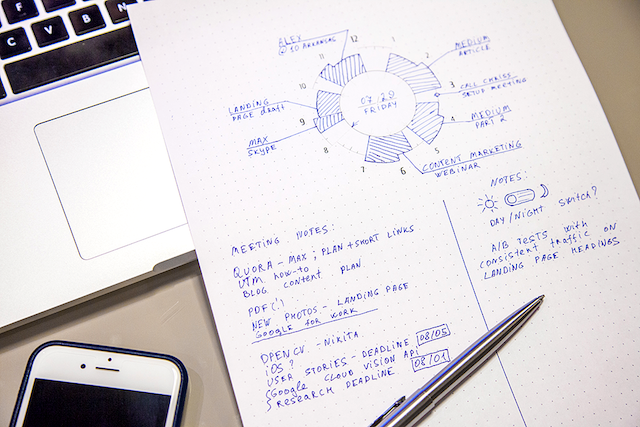
Planning is a habit, just like having a cup of coffee every morning or checking our Facebook feeds before going to sleep.
But unlike coffee or social media, planning actually makes us more efficient. Good time management, increased productivity, focused attention — all of these are a result of the habitual practice of daily planning.
“We are what we repeatedly do. Excellence, then, is not an act, but a habit.” ~ Aristotle
If you can find a way to strengthen your planning habits, you can consistently arrive at better results. In order to see where I’m going with it, I suggest you do this simple exercise:
Imagine the schedule you would put together for an important day. Would it be on your computer or phone, on paper, or, maybe, in your mind?
Planning implies putting your goals into a timeline. The timeline then allows you to measure your progress.
There is one thing that we all have in common — most of us tend to visualize time as a straight line. And all the timelines is a reflection of the linear perception of time.
Can you think of another concept of time that we all know but never use for planning? The Circular Timeline isn’t an invention, nevertheless, it is a great solution for visual thinkers.
Sixty-five percent of people in the world are visual thinkers. We learn, think, and plan using visual memory, which reassembles objects in the mental image.
Here is a quiz for you : Which clock would you pick?

Obviously, there is no difference in the output, both visual representations tell us the same thing. But if you pick the digital clock you can always see the exact time, whereas with analog you may not care if it’s 37 or 38 minutes after the house. And here is my understanding:
Analog: You see the past, the present, and the future.
Digital: You only see the present.
That fact, in particular, is interesting when we talk about the timeline of events throughout the day. A simple realization of the difference between digital and analog clocks served as a foundation for my future concept of a daily planner.
Creating a Planner for Myself
My road toward the creation of a day planner emerged from my need for an intelligent visual tool to improve work efficiency and scheduling.
I’ve always used paper planners and digital calendars. But whatever format I use, my brain is building a projection of events from the timeline. Actually, digital calendars do it pretty well, and I can certainly see where I am in time, moment by moment. Still, I really miss looking at my analog watch and having an immediate sense of time.
It got me thinking: Why not project daily events from a calendar to an analog clock format?
It was a simple idea, and I’m quite sure that I was not the first one who discovered it. I needed a clock face where I could place all my appointments and events.
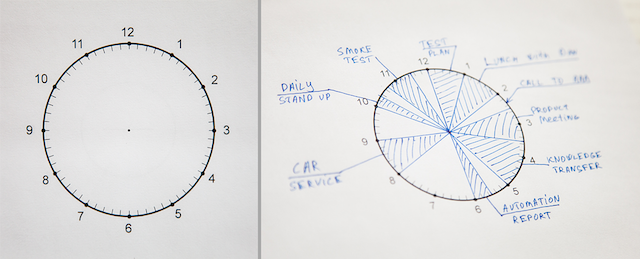
My initial clock face concept came off a bit cluttered, even with my beautiful, calligraphy-esque writing skills (dripping sarcasm intended). I quickly iterated on my clock face concept, creating a simple “doughnut” diagram as seen below:

My concept differed from similar diagrams in that I eschewed a 24-hour format for a 12-hour one. After all, how many of us routinely work for more than 12 hours a day? (If you do, you have my condolences!)
Drafting and Tweaking the Clock Face Concept
Eventually, I began printing my circular “doughnut” diagrams and integrating them into my daily routine.
Version 1. Arrows were added to indicate the start hour of each work day.
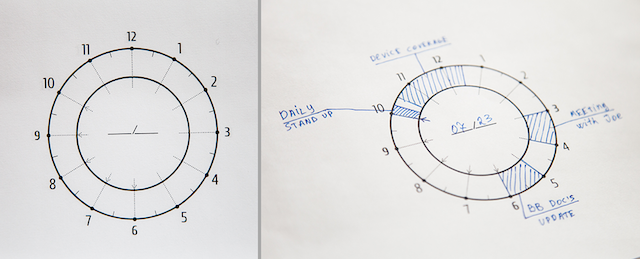
Version 1. Arrows added.
Version 2. Lines were slimmed out. These thinner lines further streamlined the calendar. Fifteen-minute delimiters were also added.
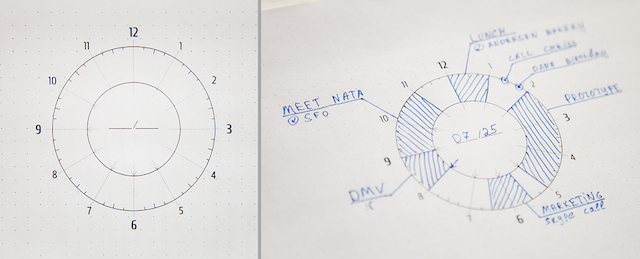
Version 2. Delimiters added.
Version 3. Current. The next iteration of the concept came out recently when I found Chronodex whose predecessor was the long-gone Singapore-based Muji Chronotebook.
They use a more advanced radial representation that is able to fit in all 24 hours based on the Asian perception of time unfolding. I thought that might be an overkill for a regular guy like me (plus I’d need to read the manual first), but adopting the slightly exploded doughnut pie chart model seemed like a really good idea.
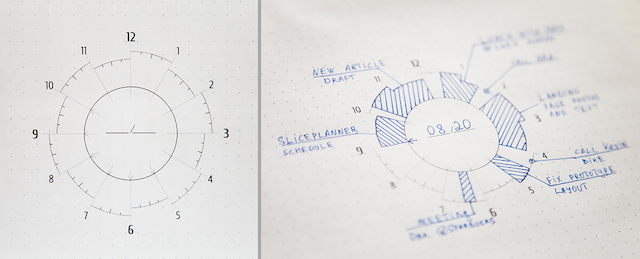
Version 3. Exploded “doughnut”
You can see the results above. Sure, you can’t plan two tasks concurrently, but recent research suggests that attempts at multitasking are counterproductive, anyway. Our brains just weren’t wired to multitask.
I found using this diagram as simple as glancing at an analog watch. I can see the past, the present, and the future while enabling myself to envision a single portion of the day relative to the whole day.
A clock face design taps into how our minds work, increasing focus and aiding in time management. You can see your daily schedule laid out as you would imagine it on a clock face. It’s a bit more natural than a regular planner where you see all your events in the linear format of a plain text.
But what’s the benefit?
I’ve found that the effectiveness of my planning has been bolstered and that I’ve become more organized overall.
I’m so pleased with the result that I want to share it with you.
The PDF contains the circular diagram and has a dot-grid background (for Letter paper size). This may also be printed and assembled by you for your favorite notebook/planner size.
I hope you find it to be a pleasure to use and a helpful time management assistant each day!
Here is how my day looks like now:

Daily plans in circular diagram
Treat this approach as an appetizer for all there is to be reimagined about time management for visual thinkers. If you have specific questions or need advice about how to use the circular timeline, let me know in the comments below!
Good luck with your planning!
Author: Oleksii Deinega
Image: Courtesy of Author
Editor: Travis May










Read 0 comments and reply